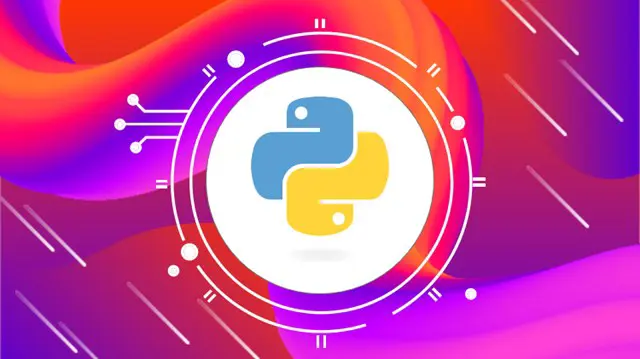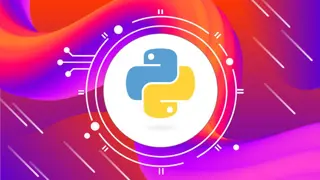- Reed courses certificate of completion - Free

Machine Learning and Deep Learning A-Z: Hands-On Python
Oak Academy
Python Machine Learning and Python Deep Algorithms in Python Code templates included. Python in Data Science | 2021
Summary
Overview
Certificates
Reed courses certificate of completion
Digital certificate - Included
Will be downloadable when all lectures have been completed
Curriculum
-
Python, Machine Learning and Deep Learning Code Files And Resources 05:00
-
Data Visualisation - Matplotlib 1:45:10
-
Data Visualization - Seaborn 1:21:15
-
Data Visualisation - Geoplotlib 43:46
-
First Contact with Machine Learning 08:44
-
Evalution Metrics in Machine Learning 45:00
-
Supervised Learning with Machine Learning 11:27
-
Linear Regression Algorithm 1:08:42
-
Bias Variance Trade-Off in Machine Learning 09:30
-
Logistic Regression Algorithm in Machine Learning A-Z 1:28:02
-
K Nearest Neighbors Algorithm 56:18
-
Decision Trees And Random Forest Algorithm 57:03
-
Support Vector Machine Algorithm 47:13
-
Unsupervised Learning 03:26
-
K Means Clustering Algorithm 47:09
-
Hierarchical Clustering Algorithm 15:45
-
Principal Component Analysis (PCA) 25:47
-
Recommender System Algorithm 41:09
-
Fundamentals of Machine Learning 2:58:31
-
Artificial Neural Network 1:32:44
-
Convolutional Neural Network 15:16
-
Recurrent Neural Network and LTSM 13:14
-
Transfer Learning 16:08
-
Projects: Python, Machine Learning, Deep Learning 1:22:57
Course media
Description
Hello there,
Welcome to the “Machine Learning and Deep Learning A-Z: Hands-On Python” course.
Do you know data science needs will create 11.5 million job openings by 2026?
Do you know the average salary is $100.000 for data science careers!
Data Science Careers Are Shaping The Future
-
If you want to learn one of the employer’s most request skills?
-
If you are curious about Data Science and looking to start your self-learning journey into the world of data with Python?
-
If you are an experienced developer and looking for a landing in Data Science!
In all cases, you are at the right place!
We've designed for you “Machine Learning and Deep Learning A-Z: Hands-On Python ” a straightforward course for Python Programming Language and Machine Learning.
In the course, you will have down-to-earth way explanations with projects. With this course, you will learn machine learning step-by-step. I made it simple and easy with exercises, challenges, and lots of real-life examples.
We will open the door of the Data Science and Machine Learning a-z world and will move deeper. You will learn the fundamentals of Machine Learning A-Z and its beautiful libraries such as Scikit Learn.
Throughout the course, we will teach you how to use Python to analyze data, create beautiful visualizations, and use powerful machine learning python algorithms.
Because data can mean an endless number of things, it’s important to choose the right visualization tools for the job. Whether you’re interested in learning Tableau, D3.js, After Effects, or Python, has a course for you.
In this course, we will learn what is data visualization and how does it work with python.
This course has suitable for everybody who is interested data vizualisation concept.
Learn python and how to use it to python data analysis and visualization, present data. Includes tons of code data vizualisation.
In this course, you will learn data analysis and visualization in detail.
Also during the course, you will learn:
The Logic of Matplotlib
-
What is Matplotlib
-
Using Matplotlib
-
Pyplot – Pylab - Matplotlib - Excel
-
Figure, Subplot, Multiplot, Axes,
-
Figure Customization
-
Plot Customization
-
Grid, Spines, Ticks
-
Basic Plots in Matplotlib
-
Overview of Jupyter Notebook and Google Colab
-
Seaborn library with these topics
-
What is Seaborn
-
Controlling Figure Aesthetics
-
Color Palettes
-
Basic Plots in Seaborn
-
Multi-Plots in Seaborn
-
Regression Plots and Squarify
-
-
Geoplotlib with these topics
-
What is Geoplotlib
-
Tile Providers and Custom Layers
-
This Machine Learning course is for everyone!
My "Machine Learning with Hands-On Examples in Data Science" is for everyone! If you don’t have any previous experience, not a problem! This course is expertly designed to teach everyone from complete beginners, right through to professionals ( as a refresher).
Why we use a Python programming language in Machine learning?
Python is a general-purpose, high-level, and multi-purpose programming language. The best thing about Python is, it supports a lot of today’s technology including vast libraries for Twitter, data mining, scientific calculations, designing, back-end server for websites, engineering simulations, artificial learning, augmented reality and what not! Also, it supports all kinds of App development.
What you will learn?
In this course, we will start from the very beginning and go all the way to the end of "Machine Learning" with examples.
Before each lesson, there will be a theory part. After learning the theory parts, we will reinforce the subject with practical examples.
During the course you will learn the following topics:
-
What is Machine Learning?
-
More About Machine Learning
-
Machine Learning Terminology
-
Evaluation Metrics
-
What is Classification vs Regression?
-
Evaluating Performance-Classification Error Metrics
-
Evaluating Performance-Regression Error Metrics
-
Machine Learning with Python
-
Supervised Learning
-
Cross-Validation and Bias Variance Trade-Off
-
Use Matplotlib and seaborn for data visualizations
-
Machine Learning with SciKit Learn
-
Linear Regression Theory
-
Logistic Regression Theory
-
Logistic Regression with Python
-
K Nearest Neighbors Algorithm Theory
-
K Nearest Neighbors Algorithm With Python
-
K Nearest Neighbors Algorithm Project Overview
-
K Nearest Neighbors Algorithm Project Solutions
-
Decision Trees And Random Forest Algorithm Theory
-
Decision Trees And Random Forest Algorithm With Python
-
Decision Trees And Random Forest Algorithm Project Overview
-
Decision Trees And Random Forest Algorithm Project Solutions
-
Support Vector Machines Algorithm Theory
-
Support Vector Machines Algorithm With Python
-
Support Vector Machines Algorithm Project Overview
-
Support Vector Machines Algorithm Project Solutions
-
Unsupervised Learning Overview
-
K Means Clustering Algorithm Theory
-
K Means Clustering Algorithm With Python
-
K Means Clustering Algorithm Project Overview
-
K Means Clustering Algorithm Project Solutions
-
Hierarchical Clustering Algorithm Theory
-
Hierarchical Clustering Algorithm With Python
-
Principal Component Analysis (PCA) Theory
-
Principal Component Analysis (PCA) With Python
-
Recommender System Algorithm Theory
-
Recommender System Algorithm With Python
With my up-to-date course, you will have a chance to keep yourself up-to-date and equip yourself with a range of Python programming skills. I am also happy to tell you that I will be constantly available to support your learning and answer questions.
This course has suitable for everybody who interested in Machine Learning and Deep Learning concepts.
During the course you will learn:
What is the AI, Machine Learning, and Deep Learning
-
History of Machine Learning
-
Turing Machine and Turing Test
-
The Logic of Machine Learning such as
-
Understanding the machine learning models
-
Machine Learning models and algorithms
-
Gathering data
-
Data pre-processing
-
Choosing the right algorithm and model
-
Training and testing the model
-
Evaluation
-
-
Artificial Neural Network with these topics
-
What is ANN
-
Anatomy of NN
-
Tensor Operations
-
The Engine of NN
-
Keras
-
Tensorflow
-
-
Convolutional Neural Network
-
Recurrent Neural Network and LTSM
-
Transfer Learning
In this course, we will start from the very beginning and go all the way to the end of "Deep Learning" with examples.
Before we start this course, we will learn which environments we can be used for developing deep learning projects.
Why would you want to take this course?
Our answer is simple: The quality of teaching.
When you enroll, you will feel the OAK Academy`s seasoned developers' expertise. Questions sent by students to our instructors are answered by our instructors within 48 hours at the latest.
You will be,
-
Seeing clearly
-
Hearing clearly
-
Moving through the course without distractions
You'll also get:
-
Lifetime Access to The Course
-
Fast & Friendly Support in the Q&A section
We offer full support, answering any questions.
If you are ready to learn the “Machine Learning and Deep Learning A-Z: Hands-On Python” course.
Dive in now! See you in the course!
Who is this course for?
- Machine learning isn’t just useful for predictive texting or smartphone voice recognition. Machine learning is constantly being applied to new industries and new problems. It is for everyone
- Anyone who wants to start learning "Machine Learning"
- Anyone who needs a complete guide on how to start and continue their career with machine learning
- Software developer who wants to learn "Machine Learning"
- Students Interested in Beginning Data Science Applications in Python Environment
- People Wanting to Specialize in Anaconda Python Environment for Data Science and Scientific Computing
- Students Wanting to Learn the Application of Supervised Learning (Classification) on Real Data Using Python
- People who want to learn machine learning, deep learning, python
Requirements
-
Basic knowledge of Python Programming Language
-
Be Able To Operate & Install Software On A Computer
-
Free software and tools used during the course
-
Determination to learn and patience.
-
Desire to master on python, machine learning a-z, deep learning a-z
-
Motivation to learn the the second largest number of job postings relative program language among all others
-
Data visualization libraries in python such as seaborn, matplotlib
-
Learn to create Machine Learning and Deep Algorithms in Python Code templates included.
Questions and answers
Currently there are no Q&As for this course. Be the first to ask a question.
Reviews
Currently there are no reviews for this course. Be the first to leave a review.
Sidebar navigation
Legal information
This course is advertised on Reed.co.uk by the Course Provider, whose terms and conditions apply. Purchases are made directly from the Course Provider, and as such, content and materials are supplied by the Course Provider directly. Reed is acting as agent and not reseller in relation to this course. Reed's only responsibility is to facilitate your payment for the course. It is your responsibility to review and agree to the Course Provider's terms and conditions and satisfy yourself as to the suitability of the course you intend to purchase. Reed will not have any responsibility for the content of the course and/or associated materials.
FAQs
Interest free credit agreements provided by Zopa Bank Limited trading as DivideBuy are not regulated by the Financial Conduct Authority and do not fall under the jurisdiction of the Financial Ombudsman Service. Zopa Bank Limited trading as DivideBuy is authorised by the Prudential Regulation Authority and regulated by the Financial Conduct Authority and the Prudential Regulation Authority, and entered on the Financial Services Register (800542). Zopa Bank Limited (10627575) is incorporated in England & Wales and has its registered office at: 1st Floor, Cottons Centre, Tooley Street, London, SE1 2QG. VAT Number 281765280. DivideBuy's trading address is First Floor, Brunswick Court, Brunswick Street, Newcastle-under-Lyme, ST5 1HH. © Zopa Bank Limited 2026. All rights reserved.


